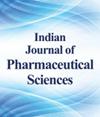Harpagide Increases microRNA-140-5p Expression to inhibit Oxidised Low-Density Lipoprotein-Caused Human Umbilical Vascular Endothelial Cell Damage
IF 0.4
4区 医学
Q4 PHARMACOLOGY & PHARMACY
Indian Journal of Pharmaceutical Sciences
Pub Date : 2023-01-01
DOI:10.36468/pharmaceutical-sciences.1174
引用次数: 0
Abstract
To investigate the influence of harpagide isolated from Scrophularia ningpoensis Hemsl. on human umbilical vascular endothelial cells damage induced by oxidized low-density lipoprotein and its possible mechanism. Human umbilical vascular endothelial cells were cultured in vitro. Different doses (20, 40, 80 μmol/l) of harpagide were applied to treat human umbilical vascular endothelial cells induced by oxidized low-density lipoprotein, human umbilical vascular endothelial cells overexpressing microRNA-140-5p were induced by oxidized low-density lipoprotein, and 80 μg/ml harpagide was applied to treat oxidized low-density lipoprotein induced human umbilical vascular endothelial cells with microRNA-140-5p downregulation. Enzyme-linked immunosorbent assay kits were used to detect malondialdehyde content as well as superoxide dismutase and glutathione peroxidase activities. Flow cytometry and Western blot were utilized to investigate cell apoptosis. Ribonucleic acid expression was analyzed by real-time quantitative reverse transcription polymerase chain reaction. Different doses of harpagide (20, 40, 80 μmol/l) reduced the malondialdehyde content and the rate of apoptosis in oxidized low-density lipoprotein-stimulated human umbilical vascular endothelial cells (p<0.05), while elevated superoxide dismutase as well as glutathione peroxidase activities (p<0.05). MicroRNA-140- 5p overexpression reduced the malondialdehyde content and apoptosis in oxidized low-density lipoproteinstimulated human umbilical vascular endothelial cells while elevated superoxide dismutase as well as glutathione peroxidase activities (p<0.05). Harpagide promoted microRNA-140-5p expression in human umbilical vascular endothelial cells after oxidized low-density lipoprotein stimulation (p<0.05). MicroRNA- 140-5p knockdown reversed the inhibitory effect of harpagide in human umbilical vascular endothelial cells (p<0.05). Harpagide up-regulates microRNA-140-5p to inhibit the oxidative stress and apoptosis of oxidized low-density lipoprotein-induced human umbilical vascular endothelial cells.Harpagide增加microRNA-140-5p表达抑制氧化低密度脂蛋白引起的人脐血管内皮细胞损伤
目的:研究从宁波县玄参中分离得到的哈巴苷的影响。氧化低密度脂蛋白致人脐血管内皮细胞损伤及其可能机制。体外培养人脐血管内皮细胞。用不同剂量(20、40、80 μmol/l)的哈帕苷处理氧化低密度脂蛋白诱导的人脐带血管内皮细胞,用氧化低密度脂蛋白诱导过表达microRNA-140-5p的人脐带血管内皮细胞,用80 μmol/ ml哈帕苷处理氧化低密度脂蛋白诱导的microRNA-140-5p下调的人脐带血管内皮细胞。采用酶联免疫吸附测定试剂盒检测丙二醛含量、超氧化物歧化酶和谷胱甘肽过氧化物酶活性。流式细胞术和Western blot检测细胞凋亡情况。实时定量逆转录聚合酶链反应分析核糖核酸表达。不同剂量的哈帕苷(20、40、80 μmol/l)降低了氧化低密度脂蛋白刺激的人脐血管内皮细胞丙二醛含量和凋亡率(p<0.05),提高了超氧化物歧化酶和谷胱甘肽过氧化物酶活性(p<0.05)。MicroRNA-140- 5p过表达降低了氧化低密度脂蛋白刺激的人脐血管内皮细胞丙二醛含量和凋亡,升高了超氧化物歧化酶和谷胱甘肽过氧化物酶活性(p<0.05)。Harpagide促进氧化低密度脂蛋白刺激后人脐血管内皮细胞microRNA-140-5p的表达(p<0.05)。MicroRNA- 140-5p敲低逆转了harpagide对人脐血管内皮细胞的抑制作用(p<0.05)。Harpagide上调microRNA-140-5p抑制氧化低密度脂蛋白诱导的人脐血管内皮细胞的氧化应激和凋亡。
本文章由计算机程序翻译,如有差异,请以英文原文为准。
求助全文
约1分钟内获得全文
求助全文
来源期刊

Indian Journal of Pharmaceutical Sciences
PHARMACOLOGY & PHARMACY-
自引率
0.00%
发文量
0
审稿时长
2 months
期刊介绍:
The Indian Journal of Pharmaceutical Sciences (IJPS) is a bi-monthly Journal, which publishes original research work that contributes significantly to further the scientific knowledge in Pharmaceutical Sciences (Pharmaceutical Technology, Pharmaceutics, Biopharmaceutics, Pharmacokinetics, Pharmaceutical/Medicinal Chemistry, Computational Chemistry and Molecular Drug Design, Pharmacognosy and Phytochemistry, Pharmacology and Therapeutics, Pharmaceutical Analysis, Pharmacy Practice, Clinical and Hospital Pharmacy, Pharmacovigilance, Pharmacoepidemiology, Pharmacoeconomics, Drug Information, Patient Counselling, Adverse Drug Reactions Monitoring, Medication Errors, Medication Optimization, Medication Therapy Management, Cell Biology, Genomics and Proteomics, Pharmacogenomics, Bioinformatics and Biotechnology of Pharmaceutical Interest). The Journal publishes original research work either as a Full Research Paper or as a Short Communication. Review Articles on current topics in Pharmaceutical Sciences are also considered for publication by the Journal.
 求助内容:
求助内容: 应助结果提醒方式:
应助结果提醒方式:


